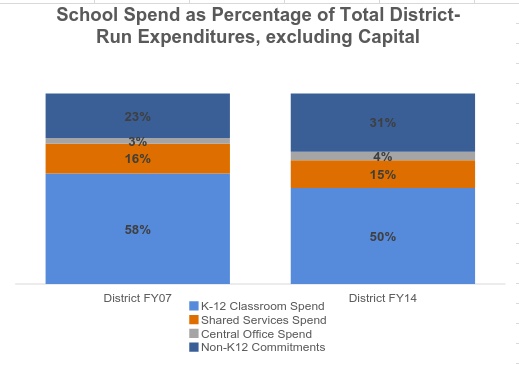This is the first installment of Afton’s five-part blog series, “How Districts Can Afford High Quality Schools, Despite Enrollment Decline,” aimed at recognizing school district financial challenges associated with enrollment decline and offering some actionable recommendations for school districts facing enrollment loss, with or without charter schools.
Earlier this year, The Center on Reinventing Public Education (CRPE) convened practitioners, funders, and researchers from across the country to contemplate the challenges that school districts face when in a period of enrollment decline, specifically when that enrollment decline is influenced by growth of charter schools. Out of that convening and various research done by CRPE, Dr. Marguerite Roza at Edunomics Lab, Afton Partners, and others, CRPE released Better Together: Ensuring Quality District Schools in Times of Charter Growth and Declining Enrollment.
Afton has completed many analyses with school districts of all sizes across the country related to the fiscal complications associated with enrollment decline, and in some cases the decline was specifically attributable to students migrating from district-run schools to charter schools. Through our work, we have sought to answer the questions:
- Why does the perception that “charters financially hurt districts” exist?
- Is this issue just perceived, or is this reality?
- If it is real, why, and what can be done at the local level to ensure (a) students in district-run schools do not end up under-resourced, and (b) quality public schools of all kinds can be supported going forward?
Our experience led us to define four major reasons that school districts with stagnant or declining enrollment could be financially impaired by opening and growing new charter schools.
- Inequitable Funding. School funding formulas used by some states and districts do not allocate resources equitably between charter school students and district-run school students, sometimes leaving district-run school students with less than equitable funding.
- Lack of District Cost Flexibility. Most school districts lack the flexibility and ability to reduce their cost structure when facing significant enrollment fluctuations; some of this stems from fixed-cost structures and legacy matters that are not possible or easy to unwind, and some of this stems from institutionalized policies and practices that districts need to change.
- Inability to Take Difficult Actions. Some school districts and stakeholders lack the willingness to take significant action necessary, such as school closures, to adjust to significant enrollment fluctuations.
- Lack of Understanding in the Charter Sector. Sometimes, charter operators have a difficult time understanding the challenges that enrollment migration presents to school districts, and are therefore hesitant to negotiate terms that would be beneficial to all students, district and charter.
THE PROBLEM: MANY PARTS OF SCHOOL DISTRICT COST STRUCTURES ARE HARD TO UNFIX
As part of work Afton conducted in a large urban school district with declining enrollment partially attributed to the increase in charter schools, we answered the question – is the district allocating more or less dollars for instructional spend than a decade ago? What we found was – yes, the district’s proportional spend on school-level expenses decreased from 58% in FY07 to 50% of budget in FY14 while enrollment declined 27% during the same period.

We found that the fixed nature of district costs was a big driver of the district’s budget shifting away from instruction during the enrollment decline. A larger portion of this district’s budget went to “non K-12 commitments”, including pension obligations, debt service, and outplacement costs. The district has managed to shrink its staff along with enrollment: staffing decreased by 31% — including 27% reduction in teachers, 37% in central office, and 33% in all other positions. However, schools have not been closed at the same rate as enrollment has been lost, meaning there are dollars tied up in administrative staffing positions and operational staff (including maintenance, janitorial, security, etc.). School count decreased by 18% while enrollment decreased by 27%. Additionally, most buildings remained owned/operated by the district, with total buildings (including school buildings, offices, and vacant buildings) decreasing by only 6% – and these extra buildings need to be maintained. Finally, contractual costs for teacher salaries increased 21% and the pension rate increased 262% over this period.
This district’s situation highlights how difficult it is to cope with enrollment loss and maintain quality instructional programming and supports. Consider that in addition to the fixed cost challenges, the school district faces challenges with how to efficiently spend dollars left for instruction. Most salaries are contractual and will increase in average cost no matter the funding available, reducing the district’s buying power for teachers. Also, migration of enrollment to charter schools is uneven from grades and schools at the district, leading to inefficient class sizes, further draining resources in non-optimal ways. All of this contributes to a feeling in schools of ‘lack of resources’, as proportional district spending at the school level shrinks and buying power for services and supports gets squeezed.
In the Appendix to CRPE’s “Better Together: Ensuring Quality District Schools in Times of Charter Growth and Declining Enrollment”, Afton shows how and why it is difficult for districts to unwind their fixed costs.
Afton’s work has shown that very few costs in a school district are truly fixed; yet many behave as fixed costs due to district decision-making (for example, contracts, teacher and other staff allocation policies, and facility footprint decisions). By understanding root causes of fixed or partially fixed costs, districts may be better able to address them. The rest of this blog series will focus on actions school districts can consider to mitigate the challenges.
- Part 2: Solutions and Remedies 1 and 2: Reinventing Funding Formulas and Services with Costs That Seem Fixed
- Part 3: Remedies 3 and 4: Infrastructure Changes and Redistricting
- Part 4: Remedies 5, 6, and 7: Curb Agreements That Inflate Costs as Enrollment Declines
- Part 5: Remedy 8: Make a Commitment to Long-Term Planning and Stop Flying Blind